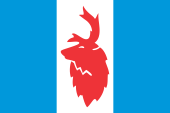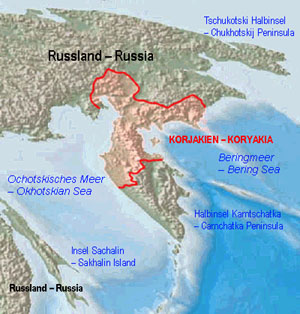Korjakien |
|
|
|
| Übersicht – Contents: | |
Diese Seite ist Teil des Projektes
Korjakien |
|
|
|
| Übersicht – Contents: | |
Flagge – Flag: |
|
 |
1998–2007, |
Bedeutung/Ursprung der Flagge – Meaning/Origin of the Flag: |
|
| Die 1998 angenommene Flagge solle die Lage Korjakiens zwischen dem Ochotskischen Meer und dem Beringmeer symbolisieren. Der Rentierkopf weist auf den wichtigsten Wirtschaftszweig der Korjaken, die Rentierzucht. | The in 1998 adoped flag should symbolize the position of Koryakia between the Okhotskian Sea and the Bering Sea. The head of the reindeer refers for the most important economical segment of the Koryakians, the reindeer culture. |
| Quelle/Source: Volker Preuß | |
Wappen – Coat of Arms: |
|
 |
Wappen – coat of arms, Quelle/Source: Unknown. Author of vectorization can be found at Vector-images.com. [Public domain], via Wikimedia Commons |
Landkarten – Maps: |
geographische Lage in Russland – geographical position within Russia: |
 Quelle/Source: Freeware, University of Texas Libraries, modyfied by: Volker Preuß |
Zahlen und Fakten – Numbers and Facts: |
|
|
|
|
|
|
|
|
|
|
|
|
|
|
|
|
|
|
|
|
Geschichte: |
| 1648 ·
Semjon Iwanow Deschnew durchstreift das Gebiet der Korjaken 1649 · teilweise Angliederung an Russland 1691 · Entdeckung der Halbinsel Kamtschatka 1697–1699 · A. Atlassow durchstreift Kamtschatka 1706 · Angliederung von Kamtschatka an Russland 1922 · Errichtung der Sowjetdiktatur 1930 · Einrichtung des Nationalen Kreises der Korjaken, später Erhebung zum Autonomen Kreis 1991 · Proklamation der Korjakischen Republik 31.12.1991 · die Sowjetunion löst sich auf, die Verfassung der Russischen Sozialistischen Föderativen Sowjetrepublik (RSFSR, Russland), ein ehemaliger Teilstaat der Sowjetunion bleibt vorerst in Kraft 25.12.1993 · eine neue Verfassung für Russland (Russische Föderation) tritt in Kraft, das Verhältnis zu den Gliedern der Föderation wird damit neu geregelt 2005 · Volksabstimmung über die Auflösung des Landes und den Anschluss an die russische Region Kamtschatka 01.07.2007 · Umwandlung des 'Autonomen Kreises der Korjaken' in den 'Korjakischen Bezirk' und Anschluss an die russische Region Kamtschatka |
History: |
| 1648 ·
Semjon Iwanow Deschnew ranges the region of the Koryakians 1649 · partial annexation to Russia 1691 · discovery of the Camchatka Peninsula 1697–1699 · A. Atlassow ranges Camchatka 1706 · annexation of Camchatka to Russia 1922 · establishment of the Soviet dictatorship 1930 · installation of the National District of the Koryakians, afterward elevation to an Autonomous District 1991 · proclamation of the Koryakian Republic 31st of December in 1991 · the Soviet Union dissolves, the constitution of the Russian Socialist Federative Soviet Republic (RSFSR, Russia), a former substate of the Soviet Union, remains in force for the time being 25th of December in 1993 · a new constitution for Russia (Russian Federation) comes into force, and the relationships with the members of the federation is re-regulated in this way 2005 · plebiscite for the dissolution of the country and the annexion to the Russian Region of Kamchatka 1st of July 2007 · conversion of the 'Autonomous Okrug of the Koryaks' into the 'Koryak District' and the annexion to the Russian Region of Kamchatka |
| Quelle/Source: Atlas zur Geschichte, World Statesmen, Die Völker der Erde, Wikipedia (D) |
Ursprung des Landesnamens – Origin of the Country's Name: |
|
| Der Name Korjakien geht natürlich auf das Volk der Korjaken zurück, das in dieser entlegenen Gegend Russlands bis ins 19. Jahrhundert hinein in der Mehrzahl war. Die Korjaken nennen sich selbst Nymylan, was "Bewohner" heißt. Die Bezeichnung "Korjaken" ist russischen Ursprungs und wenig schmeichelhaft, denn das Wort hat seine Wurzel in dem Adjektiv "korjavij", was "verwachsen" oder "krumm" bedeutet. | The name
Koryakia goes of course back to the nation of the Koryakians, which in this
outlying region of Russia was in majority till the 19th century. The
Koryakians name themselves Nymylan, what means "residents". The denomination
"Koryakians" is of Russian source and not flattering, because the word has
its roots in the adjektive "korjavij", what means "crippled" or "crooked". |
| Quelle/Source: Die Völker der Erde, Volker Preuß | |